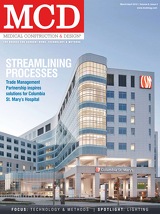Medical Construction & Design (MCD) is the industry's leading source for news and information and reaches all disciplines involved in the healthcare construction and design process. To view more past issues go to: http://mcdmag.epubxpress.com
Page 47 of 70
TECHNOLOGY & METHODS
security, fi re alarm and HVAC systems, plus standard cabling infrastructure — elements 4-D BIM can depict. However, healthcare technology refers to a plethora of devices, interactive equipment and special systems that support clinical functions. Imaging, surgical, monitoring, laboratory and other clinical devices are now linked through complex systems. Today, comprehensive technology integration is the process of connecting and confi guring these devices and systems to exchange the data necessary to support clinical operations.
Healthcare technology has a huge impact on a hospital construction proj- ect. Typically it represents one third of a hospital project construction budget — the second largest single-line item following construction. Perhaps more signifi cantly, many project stake- holders say healthcare technology represents the single largest cause for change orders and construction delays.
ADAPTING FOR CHANGE
One reason for frequent project changes and delays is construc- tion planning methodology has not adapted to accommodate advances in healthcare technology. Although many hospitals are built to have a use- ful life of from 30 to 50 years, almost no medical device commonly in use today existed 30 years ago. Major hospital construction projects typically take four or more years to complete, but healthcare technology is advanc- ing as rapidly. Unless managed from earliest planning through design, con- struction and occupancy, the technol- ogy planned during the design phase may be obsolete before the project is completed. To compound the prob- lem, healthcare technology is also becoming more complex and interac- tive. Many equipment items that used
www.mcdmag.com
The 4-D BIM model adds the fourth dimension, time, to the 3-D model, via linking with scheduling software.
to operate independently, such as diagnostic sets, infusion pumps and infant scales, are now creating and exchanging data. These equipment items may interface with multiple sys- tems provided by disparate vendors. They may generate data redundant to other equipment and require physi- cal infrastructure far beyond a simple data drop.
Given the challenges of rapid technological advancement and a typical hospital construction sched-
ule, healthcare technology integra- tion should be managed during all project phases. This ensures delivery of a technologically current, fully- equipped, interoperable facility ready to deliver patient care.
One reason for frequent project changes and delays is construction planning methodology has not adapted to ac- commodate advances in healthcare technology.
Successful healthcare technology management requires a multi-faceted approach: > Recognizing that healthcare de- livery is largely an information-based science. From physicians' observa- tions to nursing assessments and care plans, literally all decisions in healthcare are based on the clini- cian's use of information. > Understanding hospitals, not just architecturally, but also operation- ally. Key questions include: What is the workfl ow in each department? How does it vary at different times of the day or year? What systems and equipment are used? Where and how will the devices and the informa- tion generated by those devices be used? > Preparing for how the healthcare
| Medical Construction & Design 43
